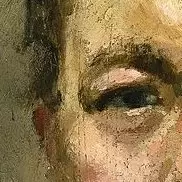Blacksmith’s Boy—Heel and Toe originally appeared in the November 2, 1940 issue of The Post alongside Edward W. O’Brien’s short story of the same title, which tells the tale of a horseshoe making contest from the point of view of a local blacksmith’s son. Forging contests like these were common tests of strength and skill in small towns throughout the United States in the early years of the 20th century, and they provided immense entertainment for the townspeople who came to watch and to place bets on the outcome. In O’Brien’s work, “Pop,” the steady, seasoned blacksmith attempts to prove his abilities against a younger and remarkably strong itinerant blacksmith named McCann, who moved from town to town participating in contests like these and was—up to this point—undefeated.
Here Rockwell depicts what is undoubtedly the climactic moment of O’Brien’s narrative, during which Pop—having fallen behind McCann—begins to gradually overtake his younger rival. The central character describes the scene with near breathless excitement: “I’ll never forget that last hour. And never, I imagine, will any of those who watched…. Both men were lost to everything now but the swing from the forge to the anvil, the heels to be turned and the toes to be welded. Nip and tuck they went, almost heel-and-toe abreast, but when Pop started singing Molly Brannigan, I knew McCann’s dog was as good as dead” (Edward W. O’Brien, “Blacksmith’s Boy—Heel and Toe,” The Saturday Evening Post, November 2, 1940, p. 11). (From Sotheby’s)


This makes me think Norman Rockwell must have done some physical labor in his life.
The posture of the blacksmith is just too perfect. It captures what it feels like to do something you’ve mastered.